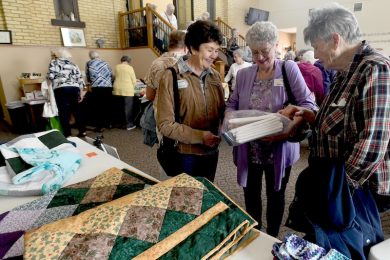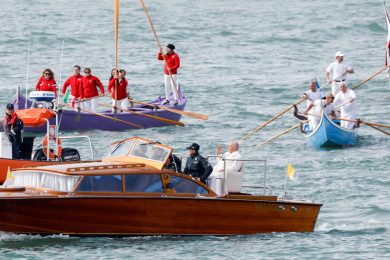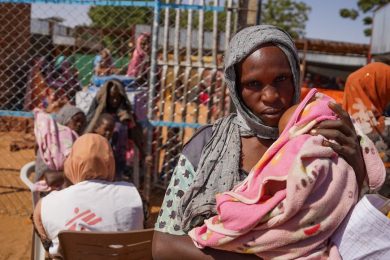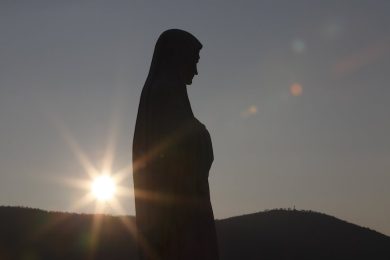With native prairie landscape, parish cultivates a mindful, yet beautiful new campus.
During the COVID-19 pandemic, Mike Niziolek was looking for a way to keep his parents connected to the Mass. When he found the livestreamed Mass from Christ Our Light in Princeton/Zimmerman, he knew he was on to something.

He was impressed with the quality of the livestream and especially Father Kevin Anderson’s homilies. So, after the pandemic he stayed involved with the parish.
Then Niziolek, a retired biology teacher, found out about the parish’s Creation Care Team and a study group based on “Laudato Si’,” Pope Francis’ letter on care for creation.
He started attending the Creation Care Team meetings, where he learned of a native prairie landscape planting project that the team had started.
“It was exciting to find, first of all, that somebody was looking at ‘Laudato Si’’,” he said. “And second, people who were passionate about planting a prairie landscape.”
Plans for that project changed and the team decided to shift their focus and resources to the development of Christ Our Light’s new campus, according to Molly Weyrens, pastoral associate.
A grant from the Franciscan Sisters of Little Falls for the previous project is now being used for a project on the grounds of the parish’s future new church building, she said.
The parish has purchased 107 acres of land between Princeton and Zimmerman where the new church will be built. Plans are still being worked out for breaking ground on it, but the Creation Care Team is already working on the prairie landscape that will go along with the new building.
“Many times, when people think of prairie, they think of something that’s just thrown away, discarded. But no,” Father Anderson said. “Because out here, there are gorgeous flowers and gorgeous bushes and grasses, and we really want to highlight that. So, our intention is to be mindful, but also create something beautiful.”
The team is working with the Sherburne Soil and Water Conservation District, a government agency that partners with the community to preserve and enhance natural resources and native habitats, to plant the native prairie landscape.
“This type of planting (Short Dry Prairie) is extremely important to Princeton/Zimmerman but also to Minnesota as a whole,” said David Wick, district technician with the Sherburne SWCD. “It is estimated that less than 2% of the original native prairie remains in Minnesota.”
After some preparation of the land, the actual planting took place on June 22, the first day of summer. Christ Our Light purchased seed from a local vendor and the SWCD planted the prairie using a no-till seed drill.
“We planted seven species of grass, and 40 species of forbs,” Niziolek said. “Forbs are flowering species on the prairie, so we’ve collected 40 different flowering species and then seven grass species.”
Some seed germination should be seen by the end of the growing season, if there is enough rain. But it will take about three years to see the plants from all of the seeds that were planted, Wick said.
Some might wonder why a plush lawn isn’t planned for the landscape around the new church thinking that these native plants are just weeds growing wild.
“These native plants that we have planted are different because they are part of a complex community, in this case a prairie community,” Niziolek said. “It is our hope that we are creating a community on the church campus that extends to include all life.”
Prairie landscapes can sequester, or remove, carbon dioxide from the atmosphere to address climate change, one of the most pressing issues when we consider life on Earth in the future, Niziolek added.
“I think part of it is, as we’re all aware of limited resources and climate change, different ways of using our resources have to start locally,” Father Anderson said. “Instead of waiting for someone out in Washington, D.C. to make some kind of a pronouncement or some kind of change, all of us have to be aware that we can do things now. So, as we look at this whole chapter in our parish life, we want to model that. It starts right here, looking at our responsibility as Christians, our responsibility as stewards of the Earth.”
Niziolek says he doesn’t know all the answers, but this project is a step in the right direction.
“Being a biologist, ecologist, somebody who studies environmental science, I feel that it’s imperative that we, as a human race, make some changes,” he said. “And to have the opportunity to address some of these issues is special to me. I think that Pope Francis, in ‘Laudato Si’,’ speaks to a change, to make this place called Earth a great place for all living things to be.”
The biggest takeaway that people can have is that native prairie is an extremely important habitat, Wick said.
“You don’t need 10 or more acres to make a difference,” he said. “Incorporating native vegetation into existing landscaping or converting part of your lawn into native habitat is essential. Everyone doing their little part can make a massive impact.”
LEARN MORE
For more information about Creation Care Teams or help starting one in your parish, visit catholicclimatecovenant.org.





















